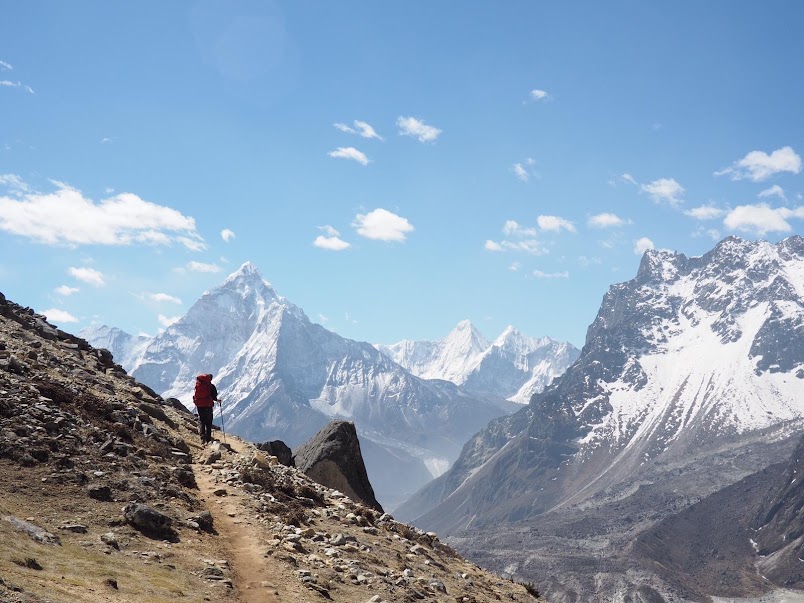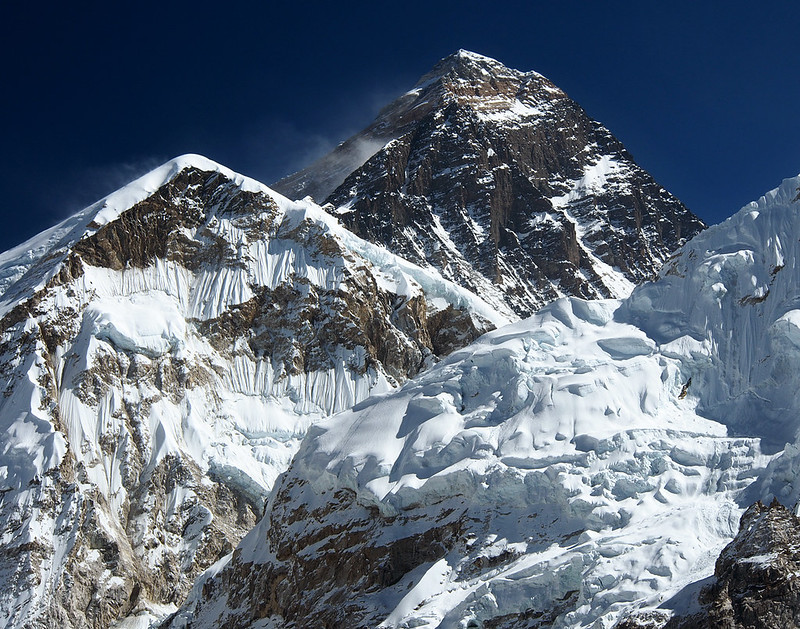Everest Base Camp Trek is a once-in-a-lifetime journey of the demanding routes around the world’s highest summits, with jaw-dropping beauty, unique cultural interactions, and a once-in-a-lifetime experience of the hard routes across the world’s highest mountains. This trip, often known as “Step to Heaven,” is on many people’s bucket lists. This walk leads daring hikers to the foot of the greatest of all mountains.

How to go to Everest Base Camp?
Everest Base Camp Trek is no easy task, but the reward is well worth the effort. Because it is one of Nepal’s most popular treks, it is often congested with visitors interested in seeing the sights. There has been a lot of debate in recent years concerning hikers’ “traffic jams,” “littering,” and the possibility of limiting the number of trekkers allowed each year.
Everest Base Camp Trek Highlights
- The most beautiful and highest viewpoint of Everest Base Camp Trek is Kalapathar.
- The Khumbu Glacier, Nepal’s largest glacier, begins at the Everest base camp and is surrounded by enormous waterfalls.
- Tengboche monastery, the Khumbu region’s oldest and largest monastery, is visited.
- The walk may be extended to include a visit to the picturesque Gokyo Lake and Gokyo Ri.
- The challenging Everest Three Highest Passes walk takes you through pristine communities and lush wilderness.
- Namche Bazar is the Khumbu region’s entryway to the stunning Sherpa communities and ethnic culture.
- Sagarmatha National Park is a great place to visit if you want to get away from it all.
What is the trek to Everest Base Camp like?
Travelers will experience a great blend of breathtaking vistas, panoramic scenery, fascinating animals, and unique local cultures during your Everest Base Camp Trek. In addition to working with local guides, guests can expect a warm welcome from teahouse owners and residents.
Every day, the journey improves, and the trekkers get a sense of accomplishment. The day begins with a stroll down a magnificent route lined with prayer flags, which leads to a series of metal bridges strung across steep gorges. Evenings are also enhanced by a teahouse fire, delectable Nepali cuisine, and talks with local guides and fellow trekkers.
The trek to Everest Base Camp is a memory to be remembered for a lifetime, thanks to the charming local culture, the eye-catching natural splendor of the Himalayas, and the warm hospitality of the inhabitants.
This voyage had a few trials in addition to the wonderful experiences, making it much more unforgettable. The technical obstacles and arduous ascent might be daunting.
The elevation rises. However, most trekkers think that hardships and obstacles are part of what makes a journey exciting, thus the difficulties are well worth it.
What is the difficulty level of the Everest Base Camp Trek?
The hike to Everest Base Camp is not very challenging. Every year, thousands of tourists trek via the Khumbu Region’s paths to the Everest Base Camp to see the world’s tallest peak. Almost everyone can tackle the journey and complete their bucket list dream with a little bit of perseverance and a lot of willingness.
Because the Everest Base Camp Trek is just a lengthy stroll at altitude, it does not need technical experience or mountaineering abilities. However, there are important considerations about physical fitness and health that must be made before the expedition can be planned.

How can I get ready for the Everest Base Camp Trek?
It’s critical to get ready for the altitude. For such journeys, cross-training and individual fitness routines prove to be beneficial. Hiking and jogging practice may also be beneficial, as the Everest Base Camp consists of the same walk and trek routine for days.
Several times a week, the individual training plan should combine aerobic, endurance, and strength training. Running, stair climbing, and other muscle-building activities should also be practiced to prepare for the Everest Base Camp. Yoga and swimming workouts can assist with respiratory control and can also be beneficial at high altitudes.
Is it better to travel by plane or by car to Lukla?
There are two ways to go to Mt. Everest Trek from Kathmandu: a flight to and from Lukla or a long adventurous off-road trip from Kathmandu to Salleri –Kharikhola-Surke locally. For a foreigner, the return flight (40 minutes one way) costs around 375 USD, whereas, for an Indian citizen, it costs around 11400 INR. If you take the road, it will cost you about 70 dollars to return. However, it will take about one and a half days to go there and back.
More than 80% of Everest trekkers will take an aircraft from Lukla to Everest Base Camp. Lukla is a remote and small yet very active airport in Nepal’s Himalayan corner. Daily flights by tiny 18-seat planes are available from early morning until mid-afternoon. Those with limited vacation time can take a flight; however, if you have longer vacation time and more than 17 days, the road is prettier; the lower Khumbu range is one of Nepal’s most beautiful rural heritage.
When is the best time for Everest Base Camp Trek?
March to May and September to December are the best months to hike to the Everest Base Camp. During May, the pathways are adorned with stunning blossoming rhododendron blooms. December may be bitterly cold, with temperatures dropping below zero degrees, yet the days are beautiful and there are few people around.
Permit for Everest Base Camp Trek
Foreign visitors to the Everest Base Camp trek and the whole Khumbu valley must purchase Local Khumbu entrance permits upon arrival in Lukla and Chaurikharka village (those arriving via Jiri), as well as a Sagarmatha National Park admission ticket from Manjo Entry Post. Nationals of SARC nations are also required for these licenses and admission tickets, although the cost is significantly cheaper than that of other visitors.
If you are on an organized trek with a guide through a trekking company in Nepal or elsewhere, they will take care of everything for you through the guide and agency in Kathmandu. While on the climb to EBC in Nepal, you only need to provide your legitimate identity or a copy of your passport.
- Foreign visitors to Sagarmatha National Park must pay a charge of 3,000 NPR plus 13% VAT, totaling 3,390 NPR (about $34).
- For SAARC nationals, the entrance cost to Sagarmatha National Park is: NPR 1,500
- From October 1, 2018, the Khumbu Pasang Lhamu Rural Municipality of Solukhumbu district has imposed a Rs 2,000 (about $20) entrance charge on any foreigner entering the rural municipality, replacing the TIMS permit: 1,000 NPR (roughly $10).
- The fee for the Khumbu Pasang Lhamu Rural Municipality must be paid at the Lukla Check Post.
Is it necessary to have a guide for Everest Base Camp Trek?
The path to Everest base camp is well signposted, so hiring a guide is not required. However, a local guide may substantially enhance the trip by providing local experiences with diverse cultures and breathtaking views.
A trekking firm can plan the journey more efficiently by coordinating all aspects of it, including airport transfers, flights, lodging, daily lunch and dinners, porters and guides, as well as their insurance.
Because the guides are educated to recognize the indications of altitude sickness, they may be of tremendous assistance to any trekker, keeping them safe along the journey.
What should I pack for the Everest Base Camp Trek?
Given the porters’ load, the packing should be light, approximately 10-15 kg. With the increase in height, the environment becomes cooler, and most tea rooms are unheated, so carrying layers is essential. Thermal underwear, long pants, and a few t-shirts are required for the base layer, while fleece jackets and long-sleeve shirts are required for the insulating layer.
The high heights necessitate the use of a raincoat and a down jacket. Gloves, a woolen cap, a torch, polarized sunglasses, a sleeping bag, and trekking poles are all essential things for the hike. Hiking or trekking boots and trekking socks, for example, must be supplied. A good first aid kit with all required medications, travel-size toiletries, filtration water bottles, and Nepalese Rupees in cash for additional requirements along the route must also be included.
Things to consider during Everest Base Camp Trek
- The Everest Base Camp trek is hardly a straightforward stroll. The trails, along with the altitude, may be dangerous and difficult. As a result, some precautions must be taken while on the hike.
- Altitude sickness is a serious issue that may strike anybody, even the most physically fit. To avoid altitude sickness, it is vital to monitor symptoms such as dyspnea, low oxygen saturation, and disorientation, and take medicine such as Diamox.
- The routes may become busy and perilous due to the sheer cliffs, which are narrowed by passing herds. To avoid being harmed or knocked off, stay attentive and remain on the inner side of the route.
- It’s also crucial to eat well and avoid stomach-upsetting foods to avoid becoming sick during the trip. Eating native cuisine, as local guides and porters do, is the safest and healthiest option.
Accommodation and lodging during Everest Base Camp Trek
In the Everest Base Camp trek route, the hotel and food services are substantially higher quality and more extensive. There are many Sherpa family-owned lodges in the area that provide hygienic restaurants with multi-cuisine menus. Daily fresh and hot Dal Bhat or locally grown Potato meals (must eat when on EBC trekking) are available, as well as Italian Pizza.
Simply the cleanest (private) rooms with the option of sharing private bathrooms. Many locations include hot showers and pleasant dining halls. There are lodges with the bare minimum of amenities above 4,000 meters, which might get crowded in the evening. If you’re traveling alone, you might have to share a room. If you’re planning a hike, have your travel company schedule it ahead of time so you don’t have to.
However, trekking to Everest Base Camp is a once-in-a-lifetime trip. The highest snowy peaks, as well as the warm traditional antagonism of the Sherpa people, are unforgettable. It’s not just the Everest Base Camp Trek, but also a nature and remoteness experience. When planning a trek to Everest Base Camp, you may schedule your trip with a Nepali local tour operator who will take care of everything for you, making it one of the safest ways to reach Everest Base Camp.